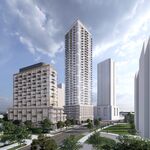scarberiankhatru
Senior Member
CityPlace existed before Concord's involvement.
Ok Waldo, where is the millions of sq. ft. of office's?
While you may claim that I have moved the goalposts, that is simply not true. Not acknowledging the latencies involved in planning and development in order to justify your position is dishonest. By your logic one can claim that Dubai is doing fine, just by looking at all that has been built in the last two years.
You have the attention span of a goldfish with dementia. Concord's CityPlace did not exist then and is not the only land in question. This has been explained to you, though it seems you'll never get it. Go back and read ShonTron's first post for an explanation.
Yes, you've moved the goalposts. Everyone else noticed this fact but you.
Funny you should bring up Dubai, because you're basing Toronto's supposed failures on a lack of speculative office towers.
They are in York and Peel.
So all you can do is cite a nebulous "loss" of "countless" buildings housing "countless" jobs, most of which could not possibly have ever been accommodated in the 416. How constructive.
The analogy was to demonstrate the spurious link you made to commercial development and public transit. In an area (Yonge and Sheppard), that was served by a subway, the opposite happened. Next time I will make it more obvious for you.
My, you are slow. Office employment exploded after the Yonge subway was extended to North York...without the Yonge extension there'd still be nothing but bungalows and strip malls in Nortth York. The same happened elsewhere in the city as transit was expanded. Downtown Toronto would be very different today if the DRL was built in the 80s. Of course, I was talking about Consumers, which you know because you made an effort to change the subject.
Who thought a 5km stubway would trigger more office towers either along Yonge or in the Consumers office park which it does not serve? What we have now is not the Sheppard subway that was planned. How can parking lots well beyond a 5km stubway compete with greenfields next to the 407? Not by sitting around and hoping for the best.
Nope. There were approvals that were changed. you might also want to have a look at figure 4.3.1 here.
Again, you're whining about a loss of potential employment space. Envisioned future development levels can be changed if infrastructure and services change, or on a whim by council. One 40 storey tower is bigger than two 20 storey towers. So some speculative towers weren't built because of the recession...shocking! Do you have a point? There's still sites left, and when the 'free' sites are gone, something can be knocked down to make room. There's a city diorama in the North York Civic Centre that shows a continuous wall of short office towers lining Yonge, most of them theoretical placeholders for future projects not yet fleshed out beyond "one day, we'd like to put a tower there." It's just a scale model of Mel Lastman's megalomania, not a reminder of what would have been had Toronto not messed up. As if the city would be healthier today if all the parking lots built in the 80s and 90s were still around.
Of course how silly of me and the rest. That is why there has been so little commercial development. We need the city to be Avenueized.
Yes, suburban Toronto does need it, which is why it's happening.
The conversions happened before Sheppard being 'Avenueized', or the construction of the subway. Using them of an example of what will happen citywide after 'Avenueizing' and Transit improvements, is false.
'Avenueization' began years ago, though not necessarily under that banner, but the conversions are still happening and houses are still being replaced with larger buildings, including commercial developments. There is no subway on Finch, by the way, just simple rezoning.




